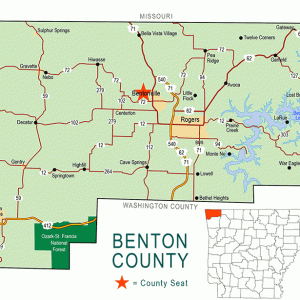calsfoundation@cals.org
Glade (Benton County)
The remote mountain community of Glade in Benton County was settled in the mid-nineteenth century. In the twenty-first century, much of that farming community is underwater due to the Beaver Lake development on the White River. Glade was transformed into a recreational area where boaters dock their boats along the lake’s edge.
One of the first recorded settlers was Abner Jennings, whose land patent was dated 1854. He built the Jennings Ferry and the Jennings Ferry Post Office before joining the Confederate army in 1861.
The community of Glade in Benton County was settled by white farmers, mostly from Tennessee and Kentucky. The weather in the Ozarks was unpredictable, but they were pleased that the average length of the growing season was almost six months. Farming in the area could be challenging, as rugged hills, forested slopes, limestone cliffs, caves, and cedar glades existed near the fertile White River bottomland.
The Battle of Pea Ridge on March 7–8, 1862, was approximately twenty miles northwest of Glade. During the Civil War, many area farms were attacked by vigilantes, and troops took animals and food. Homes were wrecked, cabins were deserted or destroyed, and rebel troops burned nearby towns. Confederate records were destroyed to prevent them from falling into the hands of the Union.
In July 1866, the federal government discontinued the Jennings Ferry Post Office. The post office reopened as the LaRue Post Office on December 27, 1867, a half mile across the White River, serving both Glade and the LaRue community. The post office remained on the southern LaRue side until July 1868, when it returned to the north side of the river, but it was still called the LaRue Post Office. Crossing the river frequently by ferry, boat, or horseback was common in those days. The location of the Glade post office was finally settled in February 1903 when Simon McGinnis’s application was approved by the federal government; this office was placed in McGinnis’s store and named the Glade Post Office.
After 1903, the LaRue and Glade communities maintained independent post offices. The Glade Post Office remained open until 1945. After it closed, rural mail carriers brought mail from Garfield (Benton County) to mailboxes perched along unpaved roads. By this time, the rugged road from Eureka Springs (Carroll County) to Rogers (Benton County) was no longer the only access to Glade. Some community members had cars, and they drove to Rogers, Garfield, or Seligman, Missouri.
The community hub was Coal Gap School; details of its origin are unknown. Records indicate that three different school buildings existed over the years. One still stands in the twenty-first century, under private ownership. School terms varied from three to seven months depending upon available community funds, and the school was under the administration of the Benton County School Board and superintendent. The building was often used for church services, revivals, community dinners, and Bible school. Baptisms were at the nearby White River. School consolidation reached the community by 1948, and students rode buses to Rogers, their first opportunity to graduate from high school.
Change accelerated in Glade after the Flood of 1927 devastated parts of Arkansas. A flood control study of the area began in 1929. The 1930s brought the Great Depression, drought, and much suffering for farmers. Lost Bridge across the White River disappeared in a flood, and the Rural Electrification Administration cut through the hills during the 1940s to bring electricity to Glade.
With the Flood Control Act of 1954, Beaver Lake was included in the comprehensive flood plan. Through eminent domain, the U.S. Army Corps of Engineers acquired land from local farmers. Dam construction began in 1960 and was completed in 1966. Land was cleared, and water soon filled the valleys and covered the farmland. By the 1990s, Glade had been transformed into a recreational destination along Beaver Lake.
As new roads and lavish lake homes rose near the water’s edge, local businesses such as boat dock maintenance and housekeeping developed. Glade occupants must travel to nearby towns of Rogers or Eureka Springs to access services and businesses. The Glade Community Historical Society works to preserve the history and heritage of the community.
For additional information:
Benton County Heritage Committee. History of Benton County, Arkansas. Rogers: Benton County Heritage Committee, 1991.
Jines, Billie. Benton County Schools That Were. Vol. 1. Ozark, MO: Dogwood Publishing, 1989.
Ross, Dorothy, Alice Carter, Amelia Osborn, Elaine Osborn, Bob Ross, and Cathy Ross, eds. Garfield and Her Ten Schools and Some Adjoining Schools. N.p.: 2000.
Patricia Heck
Glade Community Historical Society
 Benton County Map
Benton County Map 




Comments
No comments on this entry yet.